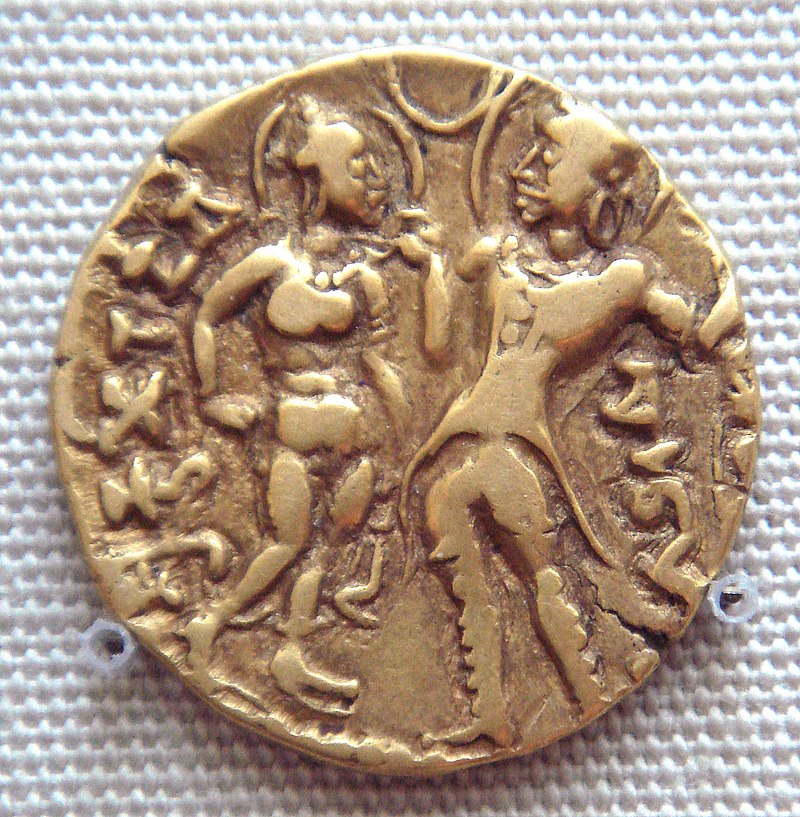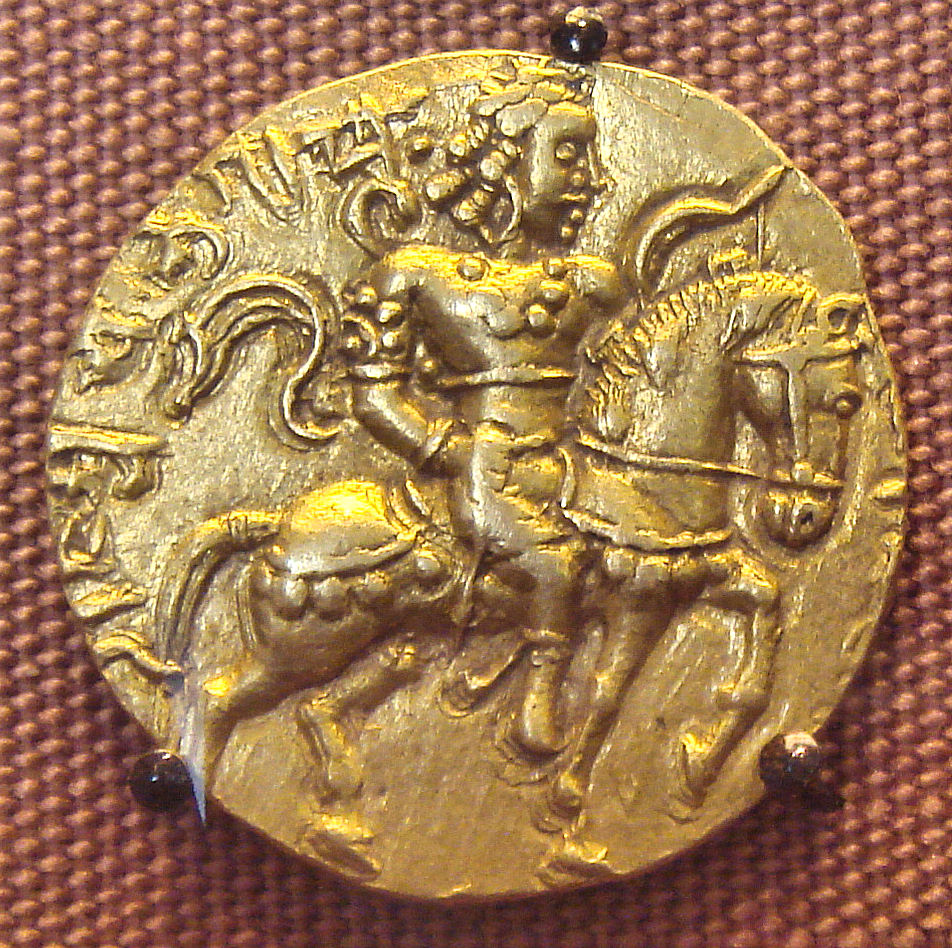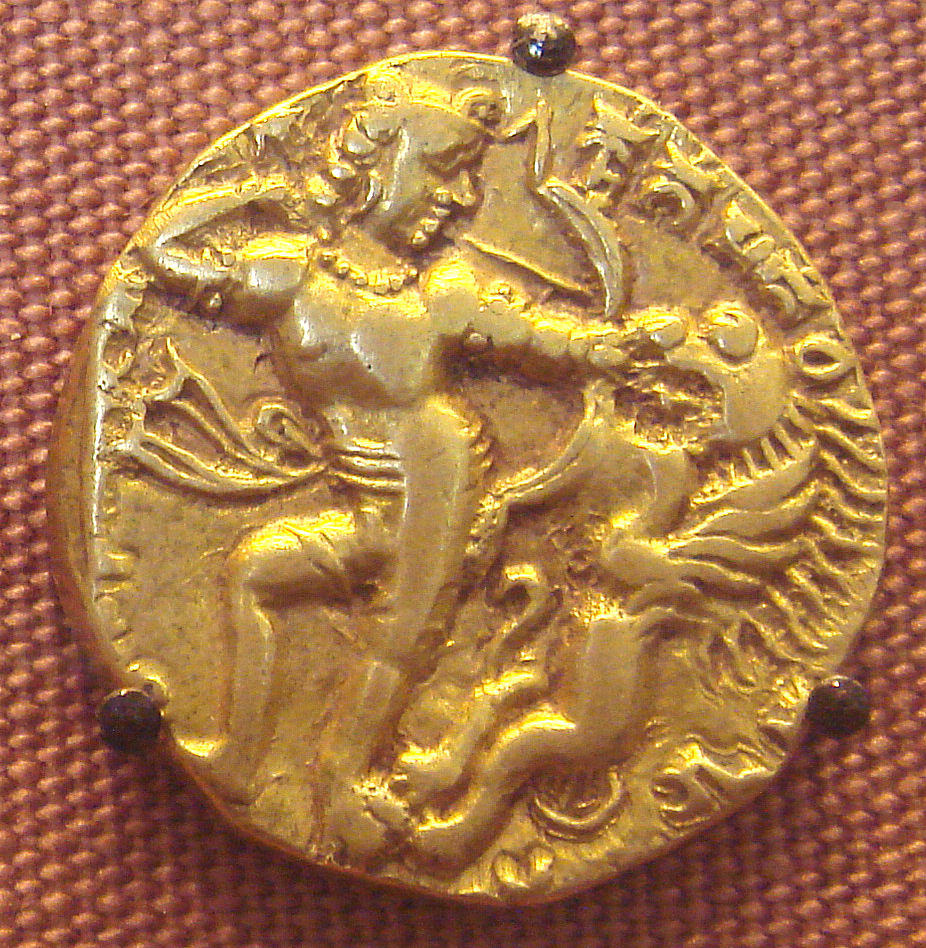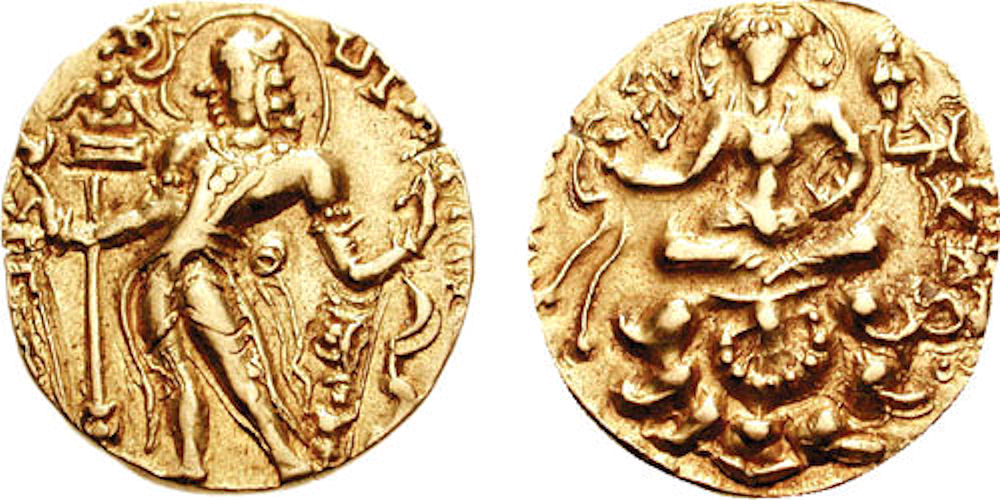The Gupta Empire was an ancient Indian empire existing from the mid-to-late 3rd century CE to 590 CE. At its zenith, from approximately 319 to 550 CE, it covered much of the Indian subcontinent. This period is called the Golden Age of India by some historians. The ruling dynasty of the empire was founded by the king Sri Gupta; the most notable rulers of the dynasty were Chandragupta I, Samudragupta, and Chandragupta II alias Vikramaditya. The 5th-century CE Sanskrit poet Kalidas credits the Guptas with having conquered about twenty-one kingdoms, both in and outside India, including the kingdoms of Parasikas, the Hunas, and the Kambojas, tribes located in the west and east Oxus valleys, the Kinnaras, Kiratas, and others.
The high points of this period are the great cultural developments that took place during the reign of Chandragupta II. All literary sources, such as Mahabharata and Ramayana, were canonized during this period. The Gupta period produced scholars such as Kalidas, Aryabhatta, Varahamihira, and Vatsyayana who made great advancements in many academic fields. Science and political administration reached new heights during the Gupta era. The period gave rise to achievements in architecture, sculpture, and painting that “set standards of form and taste determined the whole subsequent course of art, not only in India but far beyond her borders”.
The Guptas enjoyed certain material advantages. The center of their operations lay in the fertile land of Madhyadesha covering Bihar and Uttar Pradesh. They could exploit the iron ores of Central India and south Bihar. Further, they took advantage of their proximity to the areas in North India which carried on silk trade with the Byzantine Empire.
On account of these favorable factors, the Guptas set up their rule over Anuganga (the middle Gangetic basin), Prayag (modern Prayagraj), Saket (modern Ayodhya), and Magadha. In course of time, this kingdom became an All-India Empire.
The Early Guptas
An inscription tells us that Sri Gupta was the first king and Ghatotkacha was the next to follow him with the title Maharaja. This title was often borne by feudatory chiefs. The Poona copper plate inscription of Prabhavati Gupta describes Sri Gupta as the Adhiraja of the Gupta dynasty.
In the Riddhapura copper plate inscription, it is stated that Sri Gupta belonged to the Dharan Gotra.
Chandragupta I (A.D. 319-320 to 335)

As per the recorded history, the first Gupta ruler was Chandragupta I, son of Ghatotkacha. By marrying a Lichahhvi Princess Kumardevi he sought to gain in prestige, though Vaishali does not appear to have been a part of his kingdom. His rule remained confined to Magadha and parts of eastern Uttar Pradesh (Saket and Prayag). He took the title of Maharajadhiraja, and his accession in about A.D. 319-20 marked the beginning of the Gupta era.
Samudragupta (A.D. 335-380)
Chandragupta, I was succeeded by his son Samudragupta probably in A.D. 325. Samudragupta became the ruler after subduing his rival Kacha, an obscure prince of the dynasty. His conquests are known from a lengthy eulogy composed by his court-poet Harisena and inscribed on an Ashokan pillar at Allahabad. This account contains a long list of states, kings, and tribes which were conquered and brought under various degrees of subjugation.

The list can be divided into four categories:
- The first category includes the twelve states of Dakshinapatha with the names of their kings who were captured and then liberated and reinstated. They were Kosala, Mahakantara, Pishtapura, Kottura, Erandapalli, Kanchi, Avamukta, Vengi, Palakkad, Devrashtra, and Kushthalpura.
- The second category includes the names of the eight kings of Aryavarta, who were violently exterminated; prominent of them were Rudradwa, Ganapatinaga, Nagasena, etc.
- The third category consists of the rulers of the forest states (Atavirarajyas) who were reduced to servitude and the chief of the five Border States (Pratyantas) and nine tribal republics that were forced to pay all kinds of taxes obey his orders and came to perform obeisance. The five Border States were Samtata (South-east Bengal), Kamarupa (Assam), Nepal (Nepal), Davaka (Assam), and Kartipura (Kashmir). The nine tribal republics were the Malavas, Yaudheyas, Madrakas, Abhiras, Prarjunas, Arjunayanas, Sarakinakas, Kavas, and Kharaparikas.
- The fourth category consists of the Daivaputra Shahi Shahanushahi (Kushanas), the Shaka-, Murundas, the dwellers of Sinhala (Ceylon), and all the other islands who paid tribute to the King.
Harisena, the court poet of Samudragupta rightly describes him as the hero of a hundred battles, and Vincent Smith calls him the ‘Napoleon of India’. But despite his preoccupation with political and military affairs, he cultivated music and poetry. Some of his gold coins represent him as playing on the lyre. The Guptas were followers of the Brahmanical religion and Samudragupta performed the Asvamedha sacrifice. However, he fully maintained the tradition of religious toleration. According to a Chinese source, Meghavarman, the ruler of Sri Lanka was granted permission by Samudragupta to build a monastery at Bodh Gaya.
Chandragupta II (A.D. 380-412)
Samudragupta was succeeded by his younger son Chandragupta II. But, according to some scholars, Samudragupta who died shortly before A. D. 380 was succeeded by his elder son Ramagupta. The drama Devichandraguptam of Vishakhadatta suggests that Ramagupta suddenly attacked by the Sakas, made peace with them on condition that his queen Dhruvadevi was to be surrendered to the Shaka chief.

This infuriated his younger brother Chandragupta, who went himself in the disguise of the queen to the Shaka chief and killed him. Then he murdered his royal brother Ramagupta and married the queen. The official records of the Guptas however do not refer to Ramagupta and trace the succession directly from Samudragupta to Chandragupta II.
The reign of Chandragupta II saw the high watermark of the Gupta Empire. He extended the limits of the empire by marriage alliance and conquests. Chandragupta II married Kuberanaga of the Naga family. The Nagas were a powerful ruling clan and this matrimonial alliance helped the Gupta ruler in expanding his empire.
The marriage of his daughter Prabhavati by his wife Kubernaga with the Vakataka king Rudrasena II helped him to establish his political influence in the Deccan. With his great influence in this area, Chandragupta II conquered western Malwa and Gujarat from the Shaka Kshatrap, Rudrasimha III.
The conquest gave Chandragupta the Western sea coast, famous for trade and commerce. This contributed to the prosperity of Malwa, and its chief city Ujjain. Ujjain seems to have been made the second capital of Chandragupta II.
‘King Chandra’ whose exploits have been mentioned in the Mehrauli Iron Pillar Inscription, which is located in the Qutub-Minar complex in Delhi is identified by many scholars with Chandragupta II. According to this inscription, Chandra crossed the Sindhu region of seven rivers and defeated Valhikas (identified with Bacteria). It also mentions Chandragupta’s victory over enemies from Vanga (Bengal).
Chandragupta II adopted the title of Vikramaditya which had been first used by a Ujjain ruler in 57 B.C. as a mark of victory over the Shaka Kshatriya of western India. An important incident which took place during his reign was the visit of Fa-Hien, a Chinese pilgrim, who came to India in search of Buddhist texts. The court of Chandragupta II at Ujjain was adorned by numerous scholars including Kalidas and Amarasimha.
Kumaragupta I (412-454 A.D.)
Chandragupta II died about A.D. 413 and was succeeded by his son Kumaragupta who enjoyed a long reign of more than forty years. He performed the Asvamedha sacrifice, but we do not know of any military success achieved by him.

He maintained intact the vast empire built up by his two predecessors. Towards the close of his reign, the empire was menaced by hordes of the Pushyamitras probably a tribe allied to the Hunas which were defeated by the Crown prince Skandagupta.
Skandagupta (454-467 A.D.)
Skandagupta, who succeeded Kumaragupta I, was perhaps the last powerful Gupta monarch. To consolidate his position he had to fight the Pushyamitras, and the country faced Huna invasion from access to the frontiers in the north-west. However, Skandagupta was successful in throwing the Hunas back.

This heroic feat entitled him, like Chandragupta II, to assume the title of Vikramaditya. It appears that these wars adversely affected the economy of the empire, and the debased gold coinage of Skandagupta bears testimony to these. Moreover, he appears to have been the last Gupta ruler to mint silver coins in western India.
The Junagarh inscription of his reign tells us about the public works undertaken during his times. The Sudarsana Lake (originally built during the Maurya times) burst due to excessive rains and in the early part of his rule, his governor Parnadatta and his son Chakrapalita got it repaired. The last known date of Skandagupta is 467 A.D. from his silver coins.
The last days of the Gupta Empire
Skandagupta died about A.D. 467 and the line of succession after him is very uncertain. Purugupta, a son of Kumaragupta, ruled for some time and was succeeded by his son Budhagupta whose earliest known date is A. D. 477 and the latest A.D. 495. He was succeeded by his brother Narasimhagupta Baladitya.
A king named Kumaragupta II is known to have reigned in A.D. 474. This indicates internal dissension which continued after the end of Budhagupta’s reign. He was succeeded by his son and grandson, Kumaragupta III and Visnugupta – the three reigns covered the period A.D. 500-550. Two other kings, Vainyagupta (A.D. 507) and Bhanugupta (A.D. 510) ruled in Samatataand Nalandaand in Eran respectively. The Guptas continued to rule till about 550 A.D., but by then their power had already become very insignificant.
Fall of the Empire
The successors of Chandragupta II had to face an invasion by the Hunas from Central Asia in the second half of the fifth century A.D. Although in the beginning, the Gupta king Skandagupta tried effectively to stem the march of the Hunas into India; his successors proved to be weak and could not cope with the Hunas invaders. By 485 A.D. the Hunas occupied eastern Malwa and a good portion of Central India. Thus, the Hunas attacks caused a major blow to the Gupta authority particularly in northern and western regions of the empire.
The Hunas power was soon overthrown by Yashodharman of Malwa, who successfully challenged the authority of the Guptas and set up, in 532 A.D., pillars of victory commemorating his conquest of almost the whole of northern India. Yashodharman’s rule was short-lived, but it meant a severe blow to the Gupta Empire.
The policy adopted by the Guptas in the conquered areas was to restore the authority of local chiefs or kings once they had accepted Gupta suzerainty. In fact, no efforts were made to impose strict and effective control over these regions. Hence it was natural that whenever there was a crisis of succession or a weak monarchy within the Gupta Empire these local chiefs would re-establish their independent authority.
Divisions within the imperial family, the concentration of power in the hands of local chiefs or governors, the loose administrative structure of the empire, the decline of foreign trade, the growing practice of land grants for religious and other purposes, etc. contributed towards the disintegration of the Gupta Empire.

